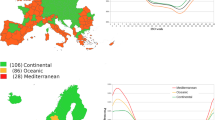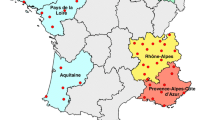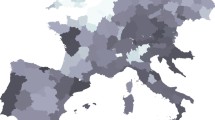Abstract
Longitudinal correlation between the North Atlantic Oscillation large-scale weather system (NAO) and the annual incidence rate of 14 viral, bacterial and protozoan national notifiable human diseases in the Czech Republic was examined. In simple correlation, cases of salmonellosis, erysipelas, infectious mononucleosis and toxoplasmosis were positively correlated with the winter NAO index, while hepatitis A and shigellosis were negatively correlated, and the other diseases tested (rubella, mumps, chickenpox, tick-borne encephalitis, Lyme borreliosis, leptospirosis, tularemia and scarlet fever) were uncorrelated with NAO. However, 8 of the 14 diseases also revealed a significant time trend, either increasing (infectious mononucleosis, salmonellosis, erysipelas, toxoplasmosis) or decreasing (hepatitis A, scarlet fever, leptospirosis, shigellosis) during the period. When the effect of NAO on incidence of the diseases was then controlled for calendar year using partial correlation analysis and detrended regression, only toxoplasmosis and infectious mononucleosis were found significantly positively correlated with the NAO when the index was lagged 1 or 2 years, and leptospirosis was correlated negatively with a lag of 2 years. Large-scale weather changes as described by NAO therefore do not seem to be a crucial factor in the fluctuation of annual incidence rate of the majority of tested infectious diseases in the Czech Republic, while other factors, especially social and public health circumstances, are obviously more important.
Similar content being viewed by others
References
ME. Loevinsohn (1994) ArticleTitleClimatic warming and increased malaria incidence in Rwanda Lancet 343 714–718 Occurrence Handle10.1016/S0140-6736(94)91586-5 Occurrence Handle1:STN:280:DyaK2c7otVKhtw%3D%3D Occurrence Handle7907685
JA Patz PR Epstein TA Burke JM. Balbus (1996) ArticleTitleGlobal climate change and emerging infectious diseases J Am Med Assoc 275 217–223 Occurrence Handle10.1001/jama.275.3.217 Occurrence Handle1:STN:280:DyaK287ptVCiug%3D%3D
WJM Martens R Slooff EK. Jackson (1997) ArticleTitleClimate change, human health, and sustainable development Bull WHO 75 583–588 Occurrence Handle1:STN:280:DyaK1c7ntVeksw%3D%3D Occurrence Handle9509631
R Colwell P Epstein D Gubler et al. (1998) ArticleTitleGlobal climate change and infectious diseases Emerg Infect Dis 4 451–452 Occurrence Handle1:STN:280:DyaK1czot1KqtA%3D%3D Occurrence Handle9716968 Occurrence Handle10.3201/eid0403.980327
PR Epstein HF Diaz S Elias et al. (1998) ArticleTitleBiological and physical signs of climate change: Focus on mosquito-borne diseases Bull Am Meteorol Soc 79 409–417 Occurrence Handle10.1175/1520-0477(1998)079<0409:BAPSOC>2.0.CO;2
J Mouchet S Manguin J Sircoulon S Laventure O Faye AW. Onapa (1998) ArticleTitleEvolution of malaria in Africa for the past 40 years: Impact of climatic and human factors J Am Mosq Control Assoc 14 121–130 Occurrence Handle1:STN:280:DyaK1czjvVKquw%3D%3D Occurrence Handle9673911
P. Reiter (1998) ArticleTitleGlobal warming and vector-borne disease in temperate regions and at high altitude Lancet 351 839–840 Occurrence Handle10.1016/S0140-6736(05)78979-0 Occurrence Handle1:STN:280:DyaK1c7nvVyiug%3D%3D Occurrence Handle9519996
DM Engelthaler DG Mosley JE Cheek et al. (1999) ArticleTitleClimatic and environmental patterns associated with hantavirus pulmonary syndrome, Four Corners region, United States Emerg Infect Dis 5 87–94 Occurrence Handle1:STN:280:DyaK1M7otFGitA%3D%3D Occurrence Handle10081675
E Lindgren L Tälleklint T. Polfeldt (2000) ArticleTitleImpact of climatic change on the northern latitude limit and population density of the disease-transmitting European tick Ixodes ricinus Environ Health Persp 108 119–123 Occurrence Handle1:STN:280:DC%2BD3c7itlymug%3D%3D
DJ Gubler P Reiter KL Ebi W Yap R Nasci JA. Patz (2001) ArticleTitleClimate variability and change in the United States: Potential impact on vector- and rodent-borne diseases Environ Hlth Persp 109 IssueIDSuppl 2 223–233
P. Reiter (2001) ArticleTitleClimate change and mosquito-borne diseases Environ Health Persp 109 IssueIDSuppl 1 141–161
RS Kovats DH Campbell-Lendrum AJ McMichael A Woodward JH. Cox (2001) ArticleTitleEarly effects of climate change: Do they include changes in vector-borne disease? Phil Trans R Soc Lond B 356 1057–1068 Occurrence Handle1:STN:280:DC%2BD3MvntVChtQ%3D%3D
EK Lipp A Huq RR. Colwell (2002) ArticleTitleEffects of global climate on infectious disease: The cholera model Clin Microbiol Rev 15 757–770 Occurrence Handle10.1128/CMR.15.4.757-770.2002 Occurrence Handle12364378
CR Franke M Ziller C Staubach M. Latif (2002) ArticleTitleImpact of El Niño/Southern Oscillation on visceral leishmaniasis, Brazil Emerg Infect Dis 8 914–917 Occurrence Handle12194766
PR. Hunter (2003) ArticleTitleClimate change and waterborne and vector-borne disease J Appl Microbiol (Suppl 94) 37–46 Occurrence Handle10.1046/j.1365-2672.94.s1.5.x
RW. Sutherst (2004) ArticleTitleGlobal change and human vulnerability to vector-borne diseases Clin Microbiol Rev 17 136–173 Occurrence Handle10.1128/CMR.17.1.136-173.2004 Occurrence Handle14726459
JW. Hurrell (1995) ArticleTitleDecadal trends in the North Atlantic Oscillation: Regional temperatures and precipitation Science 269 676–679 Occurrence Handle1:CAS:528:DyaK2MXntlCltrk%3D Occurrence Handle17758812
Z Hubálek J Halouzka Z. Juřicová (2003) ArticleTitleLongitudinal surveillance of the tick Ixodes ricinius for borreliae Med Vet Entomol 17 46–51 Occurrence Handle10.1046/j.1365-2915.2003.00408.x Occurrence Handle12680924
FJ. Rohlf (1990) NTSYS-pc numerical taxonomy and multivariate analysis system Applied Biostatistics Inc. Setauket, NY
J. Houghton (1995) Global warming: The complete briefing Lion Publishing Oxford
M Daniel V Danielová B Kříž A Jirsa J. Nožička (2003) ArticleTitleShift of the tick Ixodes ricinus and tick-borne encephalitis to higher altitudes in Central Europe Eur J Clin Microbiol Inf Dis 22 327–328 Occurrence Handle1:STN:280:DC%2BD3szhvVegug%3D%3D
P Zeman Č. Beneš (2004) ArticleTitleA tick-borne encephalitis ceiling in Central Europe has moved upwards during the last 30 years: Possible impact of global warming? Int J Med Microbiol 293 IssueIDSuppl 37 48–54 Occurrence Handle15146984
Author information
Authors and Affiliations
Corresponding author
Rights and permissions
About this article
Cite this article
Hubálek, Z. North Atlantic weather oscillation and human infectious diseases in the Czech Republic, 1951–2003. Eur J Epidemiol 20, 263–270 (2005). https://doi.org/10.1007/s10654-004-6518-3
Accepted:
Issue Date:
DOI: https://doi.org/10.1007/s10654-004-6518-3




